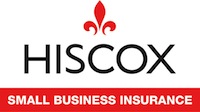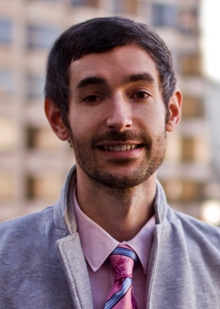Hiscox Courageous Entrepreneur Interview Series
This is part ten of the ten part series. Follow the Hiscox Courageous Entrepreneur interview series on Under30CEO.com.
Interview Series Sponsored by Hiscox Small Business Insurance. Hiscox specializes in protecting IT/technology, marketing, consulting, health and beauty, photography and many other professional services businesses, tailoring coverage to the specific risks in your industry.
“If you have a dream, you have to follow it. There is a number of people who don’t, but if you do (have a dream), you have to go pursue it.”
Dreams, like ideas you have for a business, aren’t valuable unless you act on them. They give us grand views and aspirations for the future, but it’s our responsibility to turn them from fiction into reality.
Michael Callahan is a dream jumper. He recognizes problems and opportunities and leaps at the chance to take them on himself, instead of waiting for someone else to take action.
 Michael is co-founder and CEO of ONE, a technology company whose mission is to enable all the world’s communication. It’s not a small vision, but Michael and ONE don’t take that goal lightly. They aim to create new forms of communication while making existing forms better and flow more freely.
Michael is co-founder and CEO of ONE, a technology company whose mission is to enable all the world’s communication. It’s not a small vision, but Michael and ONE don’t take that goal lightly. They aim to create new forms of communication while making existing forms better and flow more freely.
Not all communication is without controversy. The San Francisco based startup made National headlines with their anonymous social posting app for high school students — After School. Due to concerns of cyberbullying and graphic content, the App Store removed the app. Since the removal, Michael and team have made dozens of updates, several of which have never been seen on social media. One of those is a feature that allows at-risk teens to connect with someone to chat with live, which was recently mentioned in a Re/code article about the updates. “The company partnered with suicide prevention organizations so that when users type certain keywords or phrases, like “kill myself,” they’re asked to connect immediately to someone who might be able to help.”
The changes have forced the team of under ten employees to work around the clock for the past several months. Asked about the pressure that comes with innovation of this nature, Michael said “As an entrepreneur you want that stress, attention and scrutiny to be put on you because it means people care. When people care it means you’ve done something and created something of value.”
Back where it Started
It was only fitting that ONE ended up in the Bay Area, where Michael Callahan first walked into the idea for the company. While strolling down Market St. with a couple of hours to kill, he passed a group of people that he could tell were an instant fit as potential friends. He looked at them, they looked at him, and both went their separate ways. “If we could solve that problem, people could do good things.” Not only would friends be easier to come by, people would be able to easily meet new connections, future spouses, business partners, and others who they can receive value from and provide value to. The impact that serendipitous events have on our everyday lives is substantial, but often overlooked and undervalued. ONE aims to turn future situations like this into an introduction, and to turn serendipity into a science.
Communicating Without a Voice
Before ONE, Michael made headlines after debuting the Audeo, an invention that allows voiceless communication. Audeo was developed for those who have lost the ability to speak, and functions by capturing the activity sent from the brain to vocal chords. After starting out with the ability to distinguish yes from no, they worked to implement an interface without any restriction on vocabulary size. The Audeo completed the world’s first ever voiceless cellphone call in 2008.
Starting with ONE Idea
Every startup begins with an idea, but the potential of the company depends on what the founders do with that idea. Asked for his advice to early-stage entrepreneurs and how to go about taking an idea and turning it into a business, Michael advised: “A fair number of people when they go to pursue an idea, they may go asking for money without having built something first. People are usually not interested in investing. What we did first was to get the technology underway…Once we had done that, it was a more appropriate time to look for funding and resources.”
Whether looking for investment or for people to join your team, market validation is important to show others that you are working on a desired solution to a problem worth solving. To earn early market validation, Michael recommends these few simple steps:
- Tell people about your idea. By working directly with your target market, you can gauge their interest while building a list of future customers. The feedback you receive will help shift you in the right direction, or possibly prove that your idea wasn’t as good as you’d thought. Use this information to go to step 2.
- Build a false prototype. “Create something that under the hood isn’t doing what it claims to, but shows the capabilities. If you can put something together in a short amount of time that shows what the experience would be like – you can gauge interest. You can save yourself a bunch of time.”
- Innerloop and outerloop. Start with the idea and move into working on the concept. Build, and then test the concept. While in this process, there will be loops when the concept or a specific aspect of the project needs to be revisited – go back within the loop.
Inner loop: An inner loop is an iteration within product. It could be adding to the feature set or changing an aspect of the revenue model. The goal is to complete inner loops without needing to take an outer loop.
Outer loop: An outer loop is a full pivot – starting the process over and building from scratch. Understanding how to avoid outer loops in development will help in finding product-market fit and making sure what you’re building is in line with what your customers need and want.
If you take one thing from my interview with Michael Callahan, take your dreams and jump for them. Many of the things we use today and companies that are currently being built were once just dreams, but someone took action on them. Never stop dreaming, but start jumping to action.
Additional Interview Highlights
– What’s the biggest risk you took in starting ONE? “You bet everything. You really don’t perceive it as a risk because it’s a necessity – it’s something you have to do.”
– “Part of entrepreneurship in general is betting everything that you have and being completely okay with that.”
– “Entrepreneurs are amazing people. In general, if you meet someone who is an entrepreneur they’ve all had so many things that they’ve gone through and worked hard at that there is a quality about entrepreneurs that distinguishes them from other individuals.”
– “To be an entrepreneur, you first have to conquer all personal problems. You have to have full control over yourself because your ability to control a business, which is a group of people, will be too small if you haven’t mastered yourself.”
– “Whenever you have that initial idea and you want to go further, in my opinion, it’s in the best interest of the entrepreneur to figure out how to create what the product will be themselves rather than looking for people who could make it for them.
– For more on ONE, view my 2013 interview with ONE co-founder Cory Levy.
Listen to the full interview with Michael Callahan below!
[powerpress]






